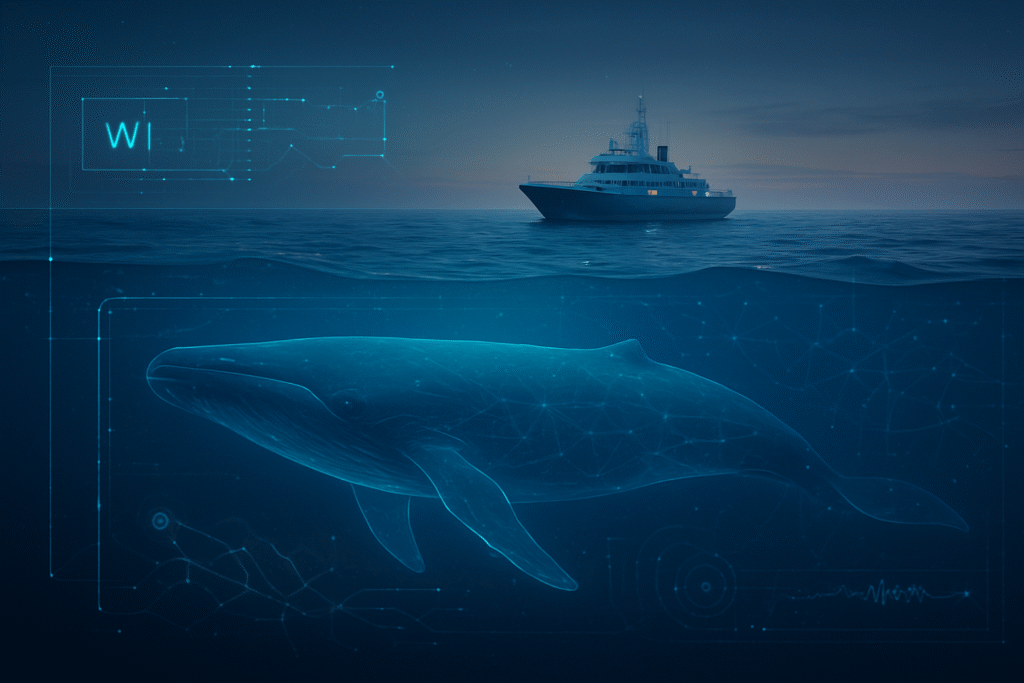
WhaleSpotter is spearheading a monumental shift in marine conservation with its breakthrough AI-driven thermal detection technology, offering an unprecedented line of defense against deadly ship collisions. This cutting-edge system utilizes highly stabilized heat-sensing cameras mounted on vessels to scan the ocean's surface day and night. When a warm whale spout or body heat is detected against the cooler ocean, an advanced neural network, meticulously trained on millions of data snippets, analyzes the footage to confirm the presence of a whale. This AI is then augmented by a crucial human verification step, where remote experts double-check detections within seconds, ensuring zero false alarms and building critical trust with ship captains to prevent "alert fatigue." This "human-in-the-loop" approach is a significant differentiator, allowing WhaleSpotter to reliably detect marine mammals up to seven kilometers away, even outperforming traditional human observers.
The immediate significance of this technological leap for environmental conservation is profound. Ship strikes are a leading cause of injury and death for whales globally, particularly for critically endangered species such as the North Atlantic right whale, with fewer than 370 individuals remaining. By providing real-time, verified alerts to ship captains, WhaleSpotter empowers them to alter course and avoid what would otherwise be fatal encounters, directly contributing to the survival of these vulnerable populations. The system's ability to operate around the clock, independent of ambient light, dramatically increases detection opportunities, especially at night when many whales are more active near the surface. With a remarkable increase from 78 detections in its first year (2019) to over 51,000 in 2024, WhaleSpotter is not only proving its efficacy but also laying the groundwork for a vast, interconnected global network that promises to safeguard marine life on an unprecedented scale.
The Technical Marvel: AI, Thermal Imaging, and Human Oversight
WhaleSpotter's core AI advancement lies in its sophisticated neural network, meticulously trained on millions of data snippets to analyze footage from highly stabilized heat-sensing cameras. These cameras, mounted on vessels, detect the warm breath (spouts) of whales against the cooler ocean mist. What truly sets WhaleSpotter apart is its "human-in-the-loop" verification system. Once the AI identifies a potential whale, an alert is sent to a remote human expert who verifies the detection within 15 seconds, with the confirmed alert reaching the ship's captain within one minute. This crucial step ensures a 99.9% detection rate with a guarantee of zero false positives, a critical factor in preventing "alert fatigue" among ship crews and fostering trust in the system. The AI algorithms are specifically designed to filter out environmental noise like waves, birds, and other vessels, focusing solely on the thermal signatures characteristic of whales.
Technically, the WhaleSpotter system is a compact, shoebox-sized solution easily mounted on a ship's deck. Its capabilities are impressive: it can reliably detect whales up to 6 kilometers, with some reports indicating up to 7 kilometers, providing ample time for large commercial vessels to alter course. A key advantage is its reliance on thermal imaging (infrared radiation), enabling effective operation both day and night, regardless of ambient light or visibility conditions—a significant improvement over visual observation methods. This 24/7 monitoring capability and real-time alerts empower ship crews to proactively avoid collisions.
This approach marks a significant departure from previous whale detection strategies. While other AI-powered thermal detection systems exist, WhaleSpotter's "purpose-built for marine conservation" design and its human verification step are crucial differentiators. Traditional methods, often relying on human observers, are limited by light, weather, and human factors, leading to inconsistent results. WhaleSpotter's continuous, high-accuracy detection provides a real-time, proactive solution, addressing a gap in previous strategies that primarily focused on route shifting or speed reduction.
Initial reactions from both the AI research community and industry experts have been overwhelmingly positive. Matson Navigation Company (NYSE: MATX), a prominent container shipping firm, announced a partnership with WhaleSpotter in November 2025, becoming the first container shipping company to deploy this advanced technology. Matson's Chairman and CEO, Matt Cox, praised the technology as "remarkable" and refined to meet "zero-false-alert requirements," highlighting the enthusiasm of their crews for its use. This partnership followed a $1 million research grant from Matson to Woods Hole Oceanographic Institution (WHOI), where the technology was developed. Marine biologists, like John Calambokidis of the Cascadia Research Collective, emphasize the system's importance as a crucial, multi-pronged approach to prevent ship-whale collisions, particularly for endangered species like the North Atlantic right whale. The global WhaleSpotter network recorded over 51,000 marine mammal detections in 2024, showcasing its rapidly expanding impact. Daniel Zitterbart, WhaleSpotter's lead scientist, envisions a future where widespread adoption creates a vast, interconnected network for real-time data, further enhancing marine mammal protection. The company, spun off from WHOI in 2024 by Shawn Henry, CEO, and Sebastian Richter, co-developer of the AI algorithm, stands on over 15 years of robust scientific research.
Competitive Implications and Market Dynamics in AI Conservation
WhaleSpotter's breakthrough, leveraging AI-powered thermal imaging and human verification, is poised to significantly impact the maritime industry and the broader technology landscape, particularly in the 2024-2025 timeframe. Having spun off as a for-profit company in 2024 from the Woods Hole Oceanographic Institution (WHOI), WhaleSpotter's focus on preventing ship-whale collisions through real-time alerts creates new competitive dynamics.
AI companies stand to benefit significantly from the advancements pioneered by WhaleSpotter. This technology exemplifies the growing "AI for Good" movement, opening new application domains in environmental monitoring and conservation. Companies with expertise in real-time object detection, thermal image analysis, and robust machine learning models for challenging environmental conditions will be in high demand. The need for AI systems that can reliably filter out noise (waves, birds, other vessels) while accurately identifying marine mammals presents complex R&D opportunities. Furthermore, the envisioned network of hundreds of vessels sharing real-time detection data will require substantial cloud computing resources for data storage, advanced analytics, and continuous AI model refinement, creating opportunities for major cloud providers such as Google Cloud, Amazon Web Services (AWS) (NASDAQ: AMZN), and Microsoft Azure (NASDAQ: MSFT).
Tech giants are likely to engage with WhaleSpotter's technology in several ways. Beyond providing scalable cloud infrastructure, companies involved in advanced sensor technology could collaborate on developing next-generation thermal cameras and ruggedized edge computing devices optimized for maritime use. As the technology matures, strategic partnerships or acquisitions of companies like WhaleSpotter could integrate whale detection into broader maritime logistics platforms or environmental intelligence services, enhancing corporate social responsibility (CSR) profiles and expanding into new vertical markets. Companies strong in geospatial data and mapping could also integrate WhaleSpotter's real-time whale detection data into maritime navigation systems.
For startups, WhaleSpotter's success highlights opportunities for new ventures focusing on niche maritime technologies, such as improved sensor stabilization, long-range communication for remote ocean areas, or advanced data compression for real-time transmission. While WhaleSpotter emphasizes its "purpose-built for marine conservation" and human verification, other companies like Awarion and SEA.AI already offer similar AI-powered thermal detection systems, creating a competitive environment where differentiation through accuracy, cost-effectiveness, and unique features is key. The "AI for Ocean" movement could also inspire startups to leverage similar technologies for broader ocean health monitoring, illegal fishing detection, or climate change impact assessment. WhaleSpotter's vision of a vast, interconnected network where hundreds of vessels share real-time data could create a significant competitive barrier, offering unparalleled situational awareness that would be difficult for individual, non-networked systems to match.
The technology also places pressure on less reliable or reactive whale avoidance strategies, pushing for more proactive and real-time solutions. Existing vessel navigation and safety systems may need to integrate real-time whale detection capabilities to remain competitive, potentially disrupting providers offering less sophisticated collision avoidance tools. WhaleSpotter's strategic advantage lies in its "human-verified for zero false-positive alerts" guarantee, which builds trust with ship captains. Its origin from WHOI provides strong scientific credibility and a clear conservation mission. The partnership with Matson Navigation Company (NYSE: MATX) in November 2025, involving a $1 million grant and deployment of units, positions Matson as a leader in adopting advanced marine protection technology and gives WhaleSpotter a critical foothold in the large commercial vessel market. For shipping companies, adopting WhaleSpotter provides significant ESG (Environmental, Social, and Governance) benefits, enhances corporate reputation, and proactively addresses growing regulatory pressures to protect marine life.
Wider Significance: AI's Role in a Healthier Ocean
WhaleSpotter's breakthrough, prominently emerging in 2024-2025, represents a significant advancement in applied artificial intelligence with wide-ranging implications for marine conservation, the shipping industry, and the broader AI landscape. Its primary impact is the direct reduction of whale mortality due to vessel strikes, which account for thousands of deaths annually. This is particularly vital for critically endangered species, such as the North Atlantic right whale, where every individual saved contributes significantly to species survival, offering a proactive solution that complements existing conservation strategies.
This technology fits squarely within several key AI trends observed in 2024-2025. It is a prime example of the "AI for Environmental Sustainability" market, which is experiencing rapid growth, projected to reach USD 100.3 billion by 2034 from USD 17.2 billion in 2024. WhaleSpotter aligns with broader efforts to use AI for habitat monitoring, wildlife protection, and climate change mitigation. The system relies on sophisticated computer vision and deep learning algorithms to process thermal imagery, reflecting the continued maturity and real-world applicability of these AI subfields. Furthermore, the deployment of AI on ships for immediate analysis and alerts demonstrates the increasing capability of real-time AI processing and advancements in edge computing.
The critical inclusion of human experts for verifying AI detections highlights a growing trend in responsible AI deployment, known as "human-in-the-loop AI." This hybrid approach ensures high accuracy ("zero false-positive alerts") and builds trust, especially in high-stakes applications where errors can have significant consequences. This approach contrasts with some earlier AI developments that perhaps over-prioritized full automation without sufficient consideration for fail-safes and human integration. WhaleSpotter also contributes to data-driven conservation, as its expanding network generates an immense volume of real-time whale detection data, which can improve understanding of whale migration patterns, distribution, and behavior, informing broader scientific research.
While offering immense positive impacts on marine conservation and maritime safety, the wider deployment of such AI systems also implicitly brings to light ongoing discussions around ethical AI development. Potential concerns, generally applicable to AI in environmental monitoring, include algorithmic bias if training data is not diverse, leading to skewed outcomes. The energy consumption and electronic waste associated with developing and deploying AI infrastructure are also considerations, although efforts are underway by companies like Google (NASDAQ: GOOGL) and Microsoft (NASDAQ: MSFT) to reduce AI's carbon footprint. Over-reliance on AI outputs without understanding contextual factors and questions of data privacy and ownership are also important considerations as these systems become more widespread.
Compared to previous AI milestones, WhaleSpotter builds upon foundational breakthroughs in computer vision by adapting these techniques to a complex and dynamic natural environment. Unlike general AI breakthroughs such as AlphaGo or large language models like GPT, WhaleSpotter represents a highly specialized, applied AI solution whose significance lies in its direct and measurable positive impact on a specific environmental problem. It reflects a maturation in AI deployment strategies, where practical application and human oversight are prioritized for reliability and trust in high-stakes environmental and safety applications. WhaleSpotter is part of a larger trend where AI is being increasingly leveraged for wildlife conservation, offering critical time for conservation action.
Future Developments and the Horizon of Marine AI
WhaleSpotter's technology, built on years of research, is poised for significant advancements beyond 2025, aiming to revolutionize marine mammal protection through enhanced automation, broader applications, and integrated data networks. In the near term, WhaleSpotter is focusing on expanding its commercial production units across a diverse range of vessels globally, including container ships, cruise ships, and research vessels. The significant partnership with Matson (NYSE: MATX) will see the technology deployed across their domestic fleet, following successful trials, with continuous refinement to meet the specific demands of large commercial vessels, ensuring consistent real-time alerts and achieving stringent "zero-false-alert requirements." The goal is to enable widespread real-time alerts for all vessels utilizing the technology, eventually sharing this collective detection information with ships not directly equipped with the system, forming an interconnected network for broader awareness.
Looking further ahead, experts envision a future where hundreds of vessels equipped with WhaleSpotter technology contribute to a vast, interconnected network of whale detection data, offering unprecedented coverage and real-time insights into whale presence and movement across vast ocean areas. Continued breakthroughs in artificial intelligence and deep learning will further enhance detection accuracy, minimize false positives and negatives, and improve the ability to distinguish specific whale calls from ambient ocean noise. The integration of AI with diverse data streams, including acoustic data, satellite information, and oceanographic conditions, is expected to enable predictive capabilities. This would allow for the creation of "probability maps" that forecast whale movements and patterns, shifting from reactive detection to proactive avoidance strategies. The broader field is also moving towards multi-sensor fusion, integrating visual cameras, sonar, lidar, and radar to provide more comprehensive and robust detection capabilities.
The evolving WhaleSpotter technology will have a wide array of applications. Beyond enhanced vessel strike mitigation, it can play a critical role in mitigating risks to whales during offshore wind farm construction and operation, informing dynamic management strategies. For natural resource exploration and subsea infrastructure projects, real-time detection can help minimize harm to marine mammals. The vast amounts of data collected will also be invaluable for scientific research, aiding in population monitoring, understanding migration routes, and assessing habitat use. Furthermore, the technology can be integrated with autonomous surface vehicles (ASVs) and drones to enhance passive acoustic monitoring and improve tracking efficiency.
Despite this promising future, several challenges must be tackled. Acquiring sufficient high-quality, annotated imagery for AI training across diverse whale species and ocean conditions remains a significant hurdle. Maintaining near-zero false positives and negatives in dynamic, acoustically noisy environments is an ongoing challenge. Broadening the adoption of the technology across a cost-sensitive maritime industry also presents a challenge, despite the clear conservation benefits. For autonomous systems, performing complex AI-driven analysis with limited onboard processing power while maintaining high accuracy is a critical hurdle.
Experts anticipate a rapid evolution in whale detection, with AI as its cornerstone, offering automated, real-time, and round-the-clock monitoring. Passive Acoustic Monitoring (PAM) will become an increasingly vital complementary tool. The shift towards predictive modeling will allow for proactive measures, with "probability maps" becoming crucial for various maritime industries. Greater collaboration and data sharing among research institutions, technology providers like WhaleSpotter, and maritime industries will be key to accelerating advancements. Autonomous drones and surface vehicles will also be increasingly utilized for data collection and collision avoidance. WhaleSpotter, by combining thermal imaging, AI, and human validation, is positioned to be a significant player in this future, contributing to a world where marine mammals and human maritime activities can coexist more safely.
A New Era for Marine Conservation
WhaleSpotter's groundbreaking whale detection technology represents a significant leap forward in marine conservation, leveraging advanced artificial intelligence to mitigate one of the most pressing threats to large marine mammals: ship collisions. The system, prominently advancing in 2024, is a revolutionary AI-powered solution designed to alert ship captains in real time to the presence of whales, enabling vessels to adjust course and prevent fatal accidents. Its core innovation lies in a neural network trained on millions of data snippets, analyzing footage from thermal cameras, augmented by a crucial human-in-the-loop verification process, where a remote expert confirms AI detections within seconds to ensure accuracy and prevent "alert fatigue." This hybrid approach is critical in applications where missing an animal is unacceptable. The technology has demonstrated impressive progress, recording over 51,000 marine mammal detections in 2024 alone, a substantial increase from its initial trials, and operates 24/7, addressing critical limitations of human observation.
This development marks a pivotal moment in the history of AI, particularly within environmental monitoring and conservation. In 2024-2025, AI's role in conservation is rapidly expanding, and WhaleSpotter exemplifies the transition from theoretical AI applications to practical, real-world solutions with tangible conservation outcomes. Its significance stems from providing real-time, actionable intelligence that directly impacts operational decisions to prevent harm, a crucial advancement over retrospective analysis. The fusion of AI and human expertise highlights a mature understanding of AI's current limitations and the necessity of human judgment in high-stakes scenarios, setting a benchmark for responsible AI deployment. As the world faces complex ecological challenges, WhaleSpotter demonstrates AI's ability to help safeguard ecosystems and mitigate human-wildlife conflicts, contributing to the broader "AI in Environmental Sustainability" movement.
The long-term impact of technologies like WhaleSpotter is poised to be transformative for ocean conservation. Widespread adoption could fundamentally reshape human interactions with marine ecosystems, leading to a drastic reduction in whale mortality due to vessel collisions and contributing directly to the recovery of endangered species like the North Atlantic right whale. The vast amounts of data collected by such a network will provide invaluable insights into whale migration patterns, behaviors, population dynamics, and responses to environmental changes, crucial for refining conservation strategies. WhaleSpotter's success could also catalyze the integration of AI with other marine monitoring technologies, creating a comprehensive "ocean intelligence" network. By making marine traffic safer for whales, the technology supports more sustainable maritime activities and can inform policy decisions, with a vision to expand information sharing to vessels not directly using the technology, creating a global network of whale detection data. However, the long-term impact also necessitates careful consideration of AI's environmental footprint and ethical standards in data collection and deployment.
In the coming weeks and months, several key areas will be crucial to monitor. Watch for initiatives to scale up WhaleSpotter's deployment across more commercial and recreational vessels, potentially through partnerships with maritime industries and regulatory bodies, as its true power will be realized when hundreds of vessels utilize this technology. Expect to see further integration of AI detection capabilities with autonomous underwater vehicles (AUVs) and drones for persistent and less invasive marine monitoring. Advances in AI will likely lead to more sophisticated predictive models that forecast whale presence based on environmental conditions, oceanographic data, and historical patterns, moving beyond simply reacting to their presence. Keep an eye on new policy and regulatory frameworks, such as those highlighted in reports by the UK government, which will guide how such technologies are implemented and regulated. Finally, anticipate the expansion of these AI models to detect diverse marine species and address other threats like illegal fishing or pollution, while simultaneously focusing on making AI itself more sustainable. WhaleSpotter, as a representative of this new wave of AI in conservation, is not merely a technological advancement but a potential catalyst for empowering conservation stakeholders and strengthening their capacity to protect the planet's biodiversity.
This content is intended for informational purposes only and represents analysis of current AI developments.
TokenRing AI delivers enterprise-grade solutions for multi-agent AI workflow orchestration, AI-powered development tools, and seamless remote collaboration platforms.
For more information, visit https://www.tokenring.ai/.






